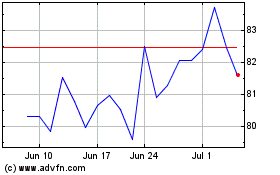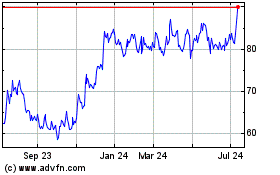UMB Financial CIO Bill Greiner Provides Mid-Year Perspective on Economy and Markets
June 22 2006 - 9:04AM
Business Wire
UMB Financial Corporation (NASDAQ: UMBF) Chief Investment Officer
Bill Greiner releases the following mid-year economic and market
outlook. Bill Greiner is chief investment officer of UMB Financial
Corporation's Asset Management Division in Kansas City, Mo. He has
spent his entire career in the investment field, with more than 25
years' investment management experience. Greiner most recently was
named Business Week's "Fearless Forecaster: 2005 Stock Market
Strategist of the Year" in December 2005. He received this
distinction by being the investment strategist who most accurately
forecasted where the U.S. markets would end up at the close of
2005. Summary Economically, things are slowing. GDP growth, after
registering strong well above-trend data for the first quarter, is
slowing as the housing market and commodity price increases are
registering a negative toll on the economy. We expect GDP growth to
slow to the 3% range during the 2nd quarter of 2006, followed by
growth in the 2.5% to 3.0% range for the remainder of the year.
Corporate profits (as measured by the S&P 500) grew by 14%
during Q1 2006. Along with overall economic momentum, we expect Q2
EPS growth to come in at 8-9%. This slowing is providing a negative
headwind to the financial markets. Along with the slowing
economic/profit momentum, the Fed continues to raise interest
rates. As a result to these two "unexpected" pressures, the S&P
corrected in price by 7.7% from early May to June 13. Over the same
period, the Russell 2000 Index declined by 13.9%. Along with
slowing economic growth (and corporate profit growth), our best
guess is the Fed will continue to raise interest rates another .25%
at the June meeting, followed by a "pause" in the upward move in
rates. If this call is wrong, we fear the Fed will continue to
raise rates without a pause, due to increasing inflationary
pressures. If this were to occur, further downside momentum in the
financial markets may unfold. Details All of this year, we have
been consistent in the message that the economy was slowing, and
corporate profit growth rates were going to contract. This appears
to be happening (at least on the economic front). Earnings season
will be upon us within the next two weeks, and we will see if the
overall slowing in growth in the economy will lead to a slowing in
reported earnings growth. Q1 GDP growth came in well above 5%
(above expectations), and consequently, Q1 EPS grew by 14%, well
above expectations, which drove the financial markets higher. As it
has become apparent that the economy is starting to slow (housing
market slowing, gasoline prices having an impact on consumer
discretionary spending), expectations for Q2 EPS growth have
started to contract. Combined with a Fed that appears to be focused
on inflationary targeting, the markets retreated. Early last month,
we called for this to occur. Now, the question evolves around how
much economic and profit growth slowing is in the cards compared to
current expectation? We believe further downside adjustments to
growth expectations are needed. Corporate Profit Growth
Expectations At the beginning of the year, the consensus forecast
for S&P 500 profit growth was in the 8% range. Following first
quarter EPS releases, many analysts ratcheted up their growth
projections for this year, topping at 10%. Now, expectations have
declined to the 9% growth level. Our expectation is that 2nd
quarter EPS growth will come in at a 9% level (down from 14% growth
during Q1). This will further drive 2006 EPS growth expectations
downward towards the 6-8% range. This may indeed provide the
catalyst for further downside adjustments in equity valuations as
the summer continues to unfold. Inflationary Expectations Building
The latest data on inflation readings are suggesting that inflation
is building at the "core" level. The 12-month core CPI measure rose
to 2.4% recently, close to the upper end of the Fed comfort zone of
1.5% to 2.5%. Furthermore, annualized core CPI inflation rates
measured over every horizon shorter than 12 months are even higher,
in many cases substantially so; the 3-month core inflation rate,
for example, is at an 11-year high of 3.8%. Strong demand,
increases in rents and perhaps some pass-through from recent
increases in energy prices have contributed to the firming of core
CPI inflation. This action may weigh heavily on the Fed, as our
expectation is for another .25% rate increase as the Fed continues
their onward quest to dampen inflationary build. What Does All This
Mean? We believe the two main drivers of equity prices (corporate
profits and inflation/interest rates) are headwinds with which the
markets will struggle against. We expect a choppy equity
environment, which started about a month ago, to continue over much
of the summer months, as corporate profit growth expectations cool
and the Fed gets a grip on inflationary trends. Themes for Equity
Investing In the face of this less-than-positive short-term view,
we sense certain themes which should be used for equity selection
and portfolio construction. These themes are: -- Large over small.
Due to valuation issues and dollar sensitivity, we believe large
cap stocks should outperform small caps for some time going
forward. -- Negative dollar play. Focus on companies who generate a
significant amount of their top line sales from foreign operations,
due to our outlook that the dollar will be under pressure over the
remainder of this year compared to other foreign currencies. --
Energy play. We believe the upward move in oil prices is secular in
nature, not cyclical. We don't think the positive outperformance of
energy stocks is yet complete. -- Capital spending. In the face of
slowing economic growth, it appears capital spending is holding up
well. Look for companies that produce items which other companies
buy to maintain profitability/competitive position. -- Health Care.
Many companies in the Health Care space are multiple plays on these
themes (large, multi-national). Bill Greiner Chief Investment
Officer, UMB Asset Management UMB Financial Corporation UMB
Financial Corporation (NASDAQ: UMBF) is a multi-bank holding
company headquartered in Kansas City, Mo., offering complete
banking and related financial services to both individual and
business customers nationwide. Its banking subsidiaries own and
operate 141 banking centers throughout Missouri, Illinois,
Colorado, Kansas, Oklahoma, Nebraska and Arizona. Subsidiaries of
the holding company and the lead bank, UMB Bank, n.a., include an
investment services group based in Milwaukee, a trust management
company in South Dakota, and single-purpose companies that deal
with brokerage services, consulting services and insurance. UMB was
named one of Business Week's "Web Smart 50" companies in 2005. UMB
Investment Advisors is a division within UMB Bank, n.a., that
manages active portfolios for employee benefit plans, endowments
and foundations, fiduciary accounts, and individuals. UMB Bank,
n.a., is an affiliate within the UMB Financial Corporation.
Securities and investment products are: Not FDIC Insured -- May
Lose Value -- No Bank Guarantee (BOXED) The opinions and forecasts
are based on information and sources of information deemed to be
reliable, but UMB Investment Advisors does not warrant the accuracy
of the information that this opinion and forecast is based upon.
Further, the information and opinions contained within this report
is subject to change at any time without notice and should not be
construed as investment advice or recommendation of any specific
security. The opinions and forecasts indicated within the report
might not come to pass.
UMB Financial (NASDAQ:UMBF)
Historical Stock Chart
From Jun 2024 to Jul 2024

UMB Financial (NASDAQ:UMBF)
Historical Stock Chart
From Jul 2023 to Jul 2024
